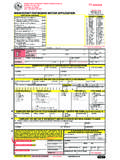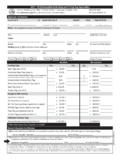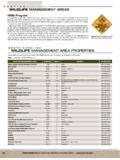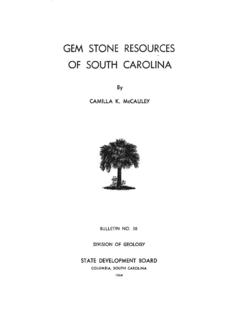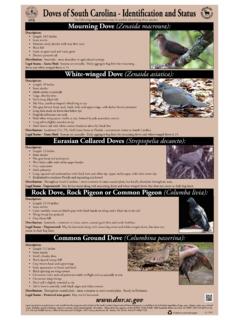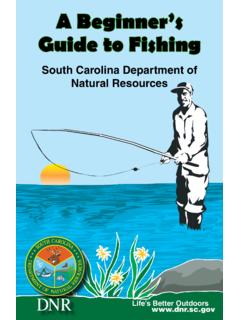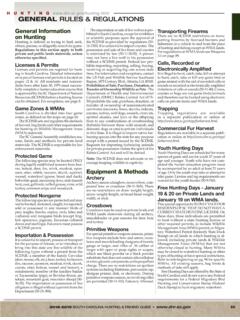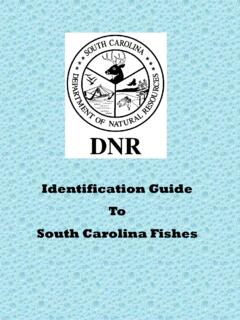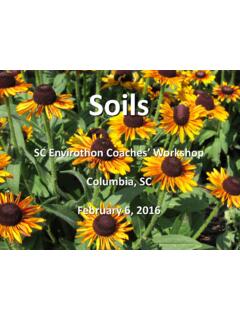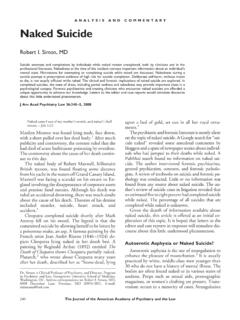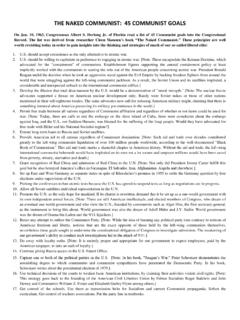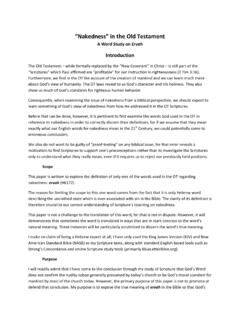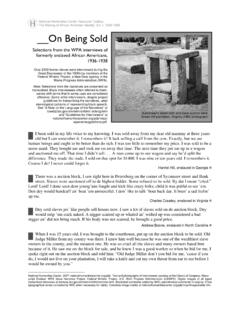Transcription of Naked goby done - South Carolina Department of Natural ...
1 Naked goby Gobiosoma bosc Contributor: David M. Wyanski DESCRIPTION Taxonomy and Basic Description The Naked goby was described by Lacep de in 1800 and given the name Gobius bosc. The genus was changed to Gobiosoma, and Gobiosoma bosc is the current scientific name. There are 9 to 10 broad, dark, vertical bars on the body, separated by narrow lighter interspaces (Dawson 1969). The common name reflects the lack of scales on the body. Dorsal fins are separate and pectoral fins are united to form a disk. Modal counts of fin elements are: dorsal spines (7), dorsal rays (13), anal rays (11), and pectoral rays (18).
2 Gobies represent the largest family of marine fishes, with more than 1,500 species worldwide (Murdy 2002). Like most gobies, Naked gobies are small, less than 60 mm ( inches) in total length, secretive, bottom-dwelling fish that depend on structures, both non-living (burrow or sunken log) or living (oyster reef), for habitat. Status Given its small size, the Naked goby is not of economic importance; however, it is of ecological importance. Although it is not a species of concern at the state or federal level, it has the potential to serve as an indicator species of estuarine health, in particular, the health of oyster reef habitat.
3 The Naked goby is an estuarine-dependent species that is numerically dominant in oyster reef habitats and likely has an integral role in the estuarine food web. Only recently have oyster reefs been formally recognized as essential habitat for finfish and crustacean species of ecological and economic importance and given the designation of Essential Fish Habitat (Coen et al. 1999a). The Naked goby is considered an estuarine-resident species (McGovern 1986; Jackson 1990; Hoffman 1991) and, more specifically, a resident species of oyster reefs in tidepools and subtidal areas (Crabtree and Dean 1982; Coen et al.)
4 1999a; Lehnert and Allen 2002). Photograph courtesy of the Gobioid Research Institute In the Chesapeake Bay, larval Naked gobies are the most abundant species in ichthyoplankton studies conducted in lower salinity areas (Dovel 1971; Breitburg 1999), and, owing to their abundance, they may consume a significant portion of copepod production in tributaries of the Chesapeake Bay (Breitburg 1999). Larval Naked gobies are prey for pelagic predators like striped bass, bluefish and weakfish that are associated with oyster reef habitat (Markle and Grant 1970; Harding and Mann 1999; Breitburg 1999).
5 POPULATION DISTRIBUTION AND SIZE The Naked goby occurs along the Atlantic coast from Massachusetts to Florida, except for extreme South Florida (Robins et al. 1986). It also occurs in coastal areas from Florida through Campeche (Mexico) in the Gulf of Mexico (Murdy 2002). All life stages (egg through adult) are very common in estuarine waters throughout the South Carolina . No estimate of population size is available. Density estimates of Naked gobies in oyster habitat are available, but area estimates of their preferred habitats, intertidal oyster habitat with tidepools and subtidal oyster habitat, need to be made in South Carolina before population size can be estimated.
6 HABITAT AND Natural COMMUNITY REQUIREMENTS The Naked goby occurs in a variety of generally shallow estuarine habitats like patches of oysters, oyster reef, saltmarsh and bare sand/mud substrate, but it is most abundant in tidepools and subtidal areas with oyster shell (Dahlberg and Conyers 1973; Crabtree and Dean 1982; Breitburg 1999; Harding and Mann 2000; Lehnert and Allen 2002; Coen 2002). In the study by Lehnert and Allen (2002) in North Inlet estuary near Georgetown, South Carolina , general trends were that: 1) numbers of fishes of all species were higher in trays of oyster shell placed in subtidal areas vs.
7 Intertidal areas, and 2) numbers of fishes were higher in shell-filled trays vs. trays with sand/mud substrate and empty trays. In the Charleston Harbor, South Carolina , estuary, Coen (2002) found that the mean density of Naked gobies was significantly greater on oyster reef vs. marsh and mud substrates. Density estimates of juveniles and adults are available from four sources. The mean density of Naked goby juveniles and adults in lift nets with oyster shells and clumps in two tidepools along the North Edisto River (Charleston County, South Carolina ) ranged from 8 to 25 individuals per 1 square meter ( individuals per square feet) during June through October (Crabtree and Dean 1982).
8 While investigating long-term oyster recruitment and predators and parasites of this bivalve, Giotta (1999) found much higher densities of Naked gobies. Using shell-filled trays placed in subtidal areas of Inlet Creek behind Sullivans Island in Charleston County, South Carolina , Giotta found 18 to 20 individuals per square meter ( individuals per square fott) for seven months, from mid-June through mid-January. Lower densities have been reported from intertidal oyster habitat without tidepools. Coen (2002) reported mean densities of 4 and 9 individuals per 1 square meter ( and individuals per square foot) during September and May, respectively, on Natural oyster reefs in intertidal areas of Inlet Creek.
9 During sampling in Jamy, July and October, Wenner et al. (1996) found an overall density of 1 goby per square meter ( individuals per square foot) on Natural and artificial oyster reefs in intertidal areas of Inlet Creek and Tolers Cove in Charleston County, South Carolina . These studies show that intertidal oyster habitats without persistent pools of seawater at low tide are utilized less frequently by the Naked goby. Oyster habitat provides a site for the Naked goby to feed and reproduce, and offers protection from predators (Dahlberg and Conyers 1973; Crabtree and Middaugh 1982).
10 Adhesive eggs are most commonly laid inside hinged shells of clean dead oysters in tidepools and subtidal areas (Dahlberg and Conyers 1973; Crabtree and Middaugh 1982). The oyster shells chosen by the Naked goby have a narrow gape so as to prevent predation on eggs (Crabtree and Middaugh 1982); shell gape is just large enough to allow entry of the fish (Dahlberg and Conyers 1973). In subtidal areas, all nests remain submerged during low spring tides and nests seem to be located where tidal current restricts siltation and stagnation at low tide (Dahlberg and Conyers 1973).
